What Motorcycles With 3D Printed Parts Are on the Market?
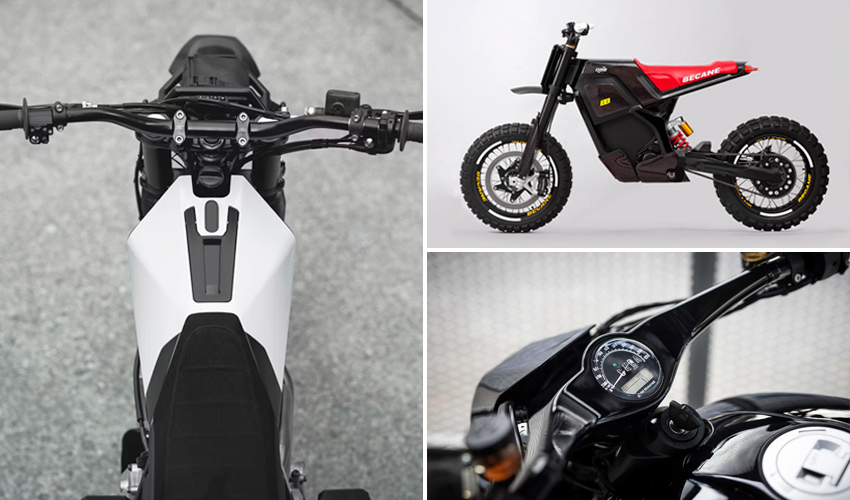
The automotive industry has been using additive manufacturing for many years. Whether for designing prototypes or finished components, in polymer or metal, 3D printing has proven very useful, bringing numerous benefits to automakers. If we zoom in on motorcycles more specifically, more and more of them are incorporating 3D printed parts. For example, many manufacturers rely on additive manufacturing to produce customized components to meet market needs, while others rely on the processes for weight reduction, time and cost savings and greater geometric complexity. Thanks to 3D printing, motorcycles can be made lighter while retaining maximum speed and rider comfort. But which motorcycles incorporate 3D printed parts? And what are these parts? Here is an overview of the current market!
DAB Motors and Becane Collaborate to Develop an Electric Motorcycle
At Paris Fashion Week, DAB Motors and Becane presented an electric motorcycle combining cutting-edge technology and futuristic design. Based on the Concept-E model, this motorcycle stands out for its avant-garde aesthetics and multiple customization options. The use of 3D printing on key components, such as the front mudguard and logos, creates a unique design and refined details. Its shiny black metallic finish catches the light, while the leather saddle, crafted in a haute couture atelier, accentuates its luxurious character. The model was unveiled in an immersive setting, inspired by the world of video games, leaving a lasting impression on participants. This collaboration highlights the potential of 3D printing and personalization in the world of electric mobility.
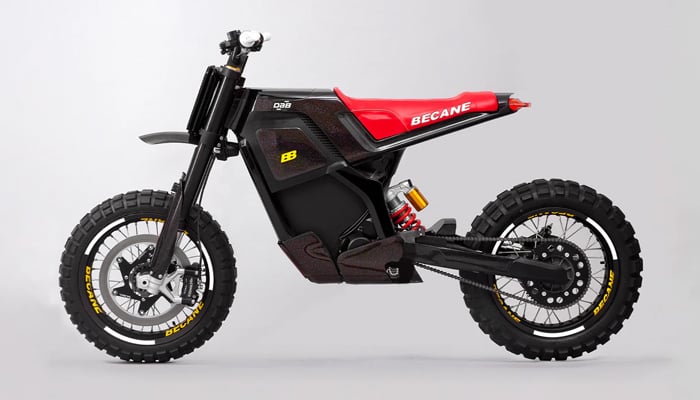
Photo Credits: Becane
Idastria Manufactures 3D printed Parts for a Motorcycle Sports Team
Idastria, a 3D services specialist based in Monza, is naturally active in the automotive sector, one of the Italian region’s most emblematic industries. In particular, the company offers SLA and FDM parts manufacturing. Wishing to broaden its offering, it has invested in a Formlabs Fuse 1 3D printer, thus integrating SLS into its portfolio and enabling it to produce high-quality parts in PA12. Thanks to this advance, Idastria has collaborated with the Moto2 SpeedUp-Boscoscuro team, equipping its motorcycles with 3D-printed parts such as airbox fittings and aerodynamic deflectors. The SLS process enabled fast, accurate production of ready-to-use parts, making it easier to manufacture spare parts and optimize design in less time.
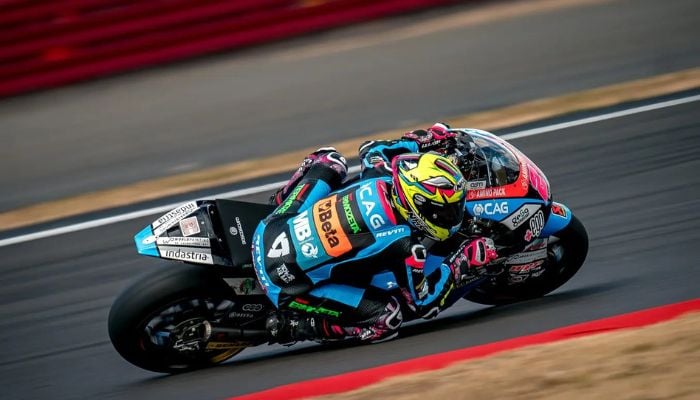
Photo Credits: Formlabs
Cara, the Motorcycle With 3D Printed Parts From VIBA
VIBA is a French design studio specializing in the manufacture of customized motorcycles. Each model is designed to achieve a certain perfection, according to the company. Among the range on offer is Cara, an elegant black motorcycle named after the famous model Cara Delevingne. What makes it special is that it features numerous 3D-printed parts. VIBA collaborated with the French ERPRO Group to design the bodywork, which was 3D printed using polyamide. The rear fairing was also designed using additive manufacturing, as was the front mudguard. The handlebars, meanwhile, were 3D printed in aluminum, incorporating the original BMW Nine-T Dashboard and a custom housing. The rear frame is also 3D-printed, this time in steel. As you can see, Cara is a perfect example of the possibilities offered by additive manufacturing, and a fine blend of 3D technologies!
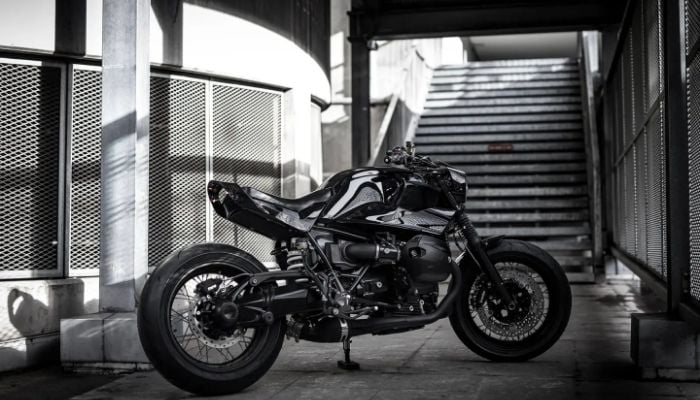
Photo Credits: VIBA
A 3D Printed Saddle for the Ego Electric Motorcycle
With its extensive experience in SLS printing of reinforced composite materials, CRP Technology has enabled Energica Motor Company to equip its Ego electric motorcycle with a 3D printed seat. This collaboration resulted in the creation of two prototypes, which underwent Energica’s certification tests and were evaluated for their ergonomics, assembly and on-road performance. The 3D-printed saddle consists of a rigid frame and a flexible part. The frame represented a major technical challenge, requiring both strength and flexibility. In addition, aesthetics, comfort and maneuverability had to be taken into account, not least because of the location of the charging socket under the seat. Thanks to its expertise and cutting-edge 3D printing technologies, CRP Technology designed a convincing prototype, considerably reducing product development time and enabling rapid prototype testing.
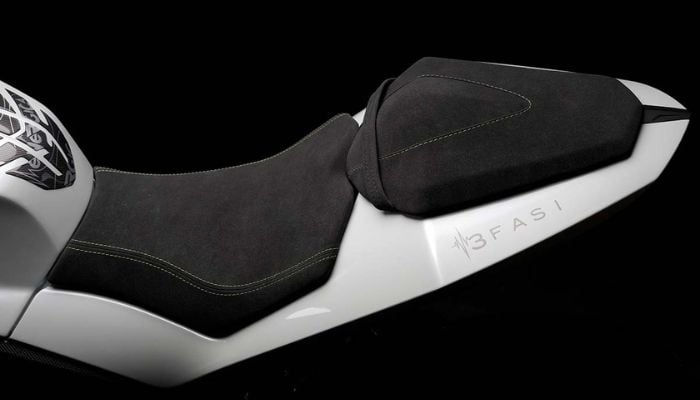
Photo Credits: Gianluca Muratori
The Honda CBF 250 Motorcycle From Born Motors
Located in Calella, near Barcelona, BORN Motor Co. specializes in the production of high-end deconstructed motorcycles. The integration of 3D printing has considerably accelerated its creative process, from design and testing to final manufacturing. Thanks to the BCN3D Sigma 3D printer, BORN engineers can now produce end-use parts in a variety of materials, such as nylon, PETG or ABS, for a wide range of applications. This technology, now an integral part of the company, enables designers to produce more complex parts with significant savings in time, effort and cost. 3D printing frees up time to concentrate on higher value-added parts, optimizing the innovation and performance of motorcycles designed by BORN Motor Co.
The Kawasaki 966 Customized by Mr Martini
Italian customizer brand Mr Martini has taken motorcycle design a step further by exploiting 3D technologies and using high-performance materials. For the Kawasaki shown here, Fabula 3D, LATI3Dlab and Mr Martini collaborated to create several elements of the bike, including the bodywork. To shape the sides and other internal components, they used carbon-fiber-reinforced filaments such as LATAMID 12 AM H2 K/15 and LATER G HT AM K/10. These materials combine strength and flexibility. Thanks to the expertise of the three partners, the result is both aesthetically pleasing and heat- and deformation-resistant. This 3D printing technology and its components are now an essential part of Mr Martini’s creative process.
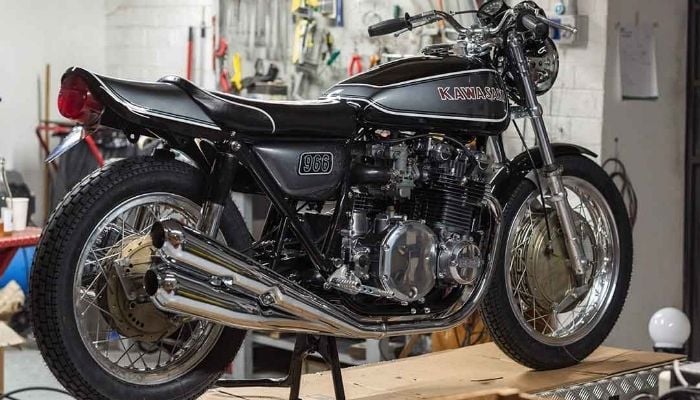
Crédits photo : LATI
“Light Rider:” The First 3D-Printed Motorcycle
APWorks, a 100% subsidiary of Airbus Group, is a pioneer in additive manufacturing, and designed what is considered to be the world’s first entirely 3D-printed motorcycle. Called Light Rider, it is made from Scalmalloy®, an APWorks exclusive material, and weighs just 35 kg. The project is a long-standing one, but one of the first of its kind. Thanks to metal 3D printing and their innovative material, APWorks was able to design an ultralight frame weighing just 6 kg, making the bike 30% lighter than traditional electric models. Powered by a 6 kW electric motor, it can reach 80 km/h in a matter of seconds. An algorithm was used to optimize the Light Rider’s structure, reducing its weight while guaranteeing sufficient resistance to the stresses of everyday riding.
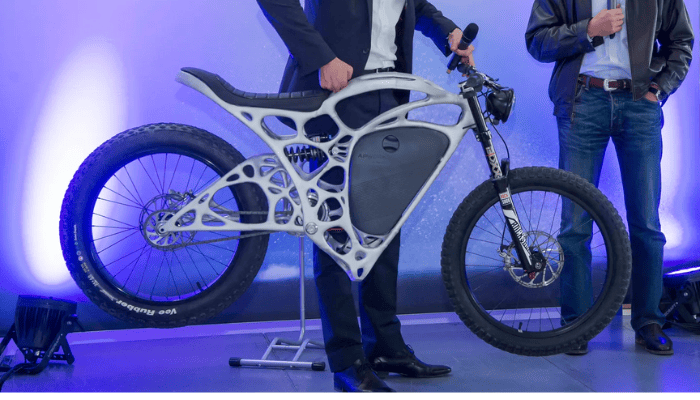
Photo Credits: Airbus
NERA, the Electric Bike From BigRep
Designed by industrial 3D printer manufacturer BigRep, the NERA bike is a real revolution. Its name, inspired by its black color, refers to the world’s first electric bike prototype to be entirely 3D printed, using just 15 parts. Conceived by designer Marco Mattia Cristofori in collaboration with the BigRep team, NERA was designed as a highly functional, fully customizable vehicle. Each component was designed to be manufactured exclusively with the company’s large-format FFF 3D printers and its specific materials: TPU 98A for handles, seat, tires and bumpers, ProHT for rigid parts, PLA to bring color and PETG for light reflectors. Only a few parts, such as the electric motor, battery, cables and control systems, were not 3D printed.
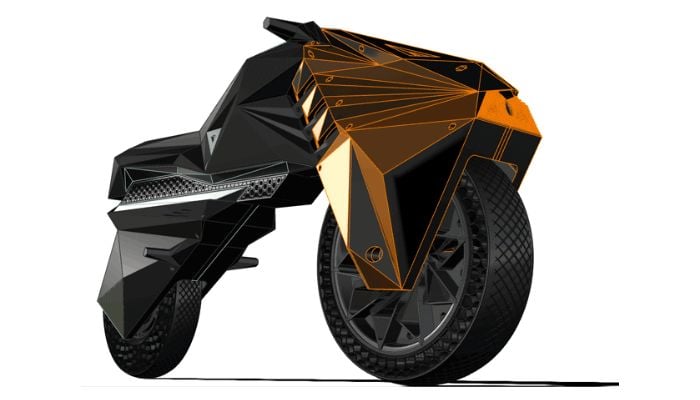
Photo Credits: BigRep
3D Printed Parts for Electric Motorcycles
Among the motorcycles available on the market that have incorporated 3D printing into their manufacturing is E-Racer’s Rugged electric motorcycle, developed in partnership with WASP. The Rugged has been redesigned from a 2018 model to be optimized for production and distribution in 2020. To speed up this process, E-Racer called on WASP to manufacture several key components of the bike: the crankcase, seat, rear, side frames and tank. The new design simplified the shapes of the components, not only improving functionality, but also reducing the bike’s weight. The parts were 3D printed in ABS, then sanded and covered with a protective coating to make them more durable and resistant to weather conditions.
The V13 Bike by Vagabund Moto
Vagabund Moto, an Austrian company specializing in motorcycle customization, stands out for its modern approach. It transforms classic motorcycles into unique models with avant-garde designs, while respecting current standards, before offering them for sale. The use of 3D printing is at the heart of their manufacturing process. This technology enables them to design customized components with great precision, as in the case of the Honda NX650, christened V13. Using polyamide 12, parts such as the fuel tank, rear end, air filter covers, switch housings and blinker brackets were printed. Thanks to additive manufacturing, Vagabund Moto guarantees a perfect finish and integrates these new parts into every motorcycle it recreates, thus combining tradition and technological innovation.
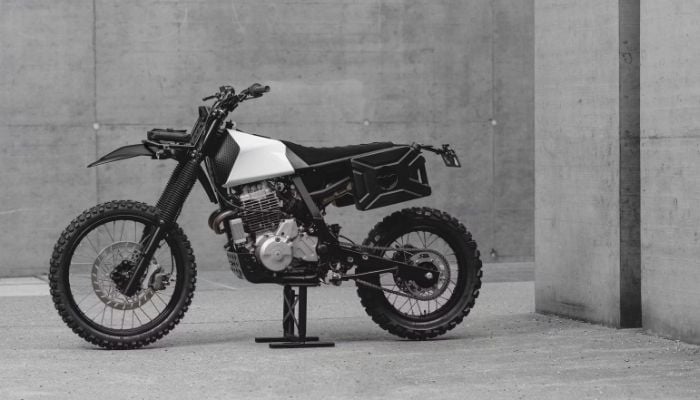
Photo Credits: Vagabun Moto
What do you think of these 3D printed motorcyles? Let us know in a comment below or on our LinkedIn, Facebook, and Twitter pages! Don’t forget to sign up for our free weekly Newsletter here, the latest 3D printing news straight to your inbox! You can also find all our videos on our YouTube channel. If you are interested in more 3D printing news in the automotive and transportation sector, visit our dedicated page HERE.







